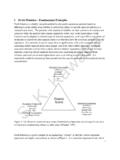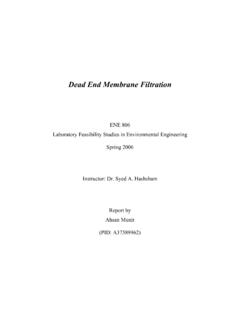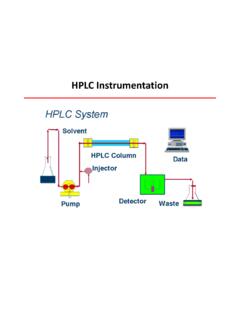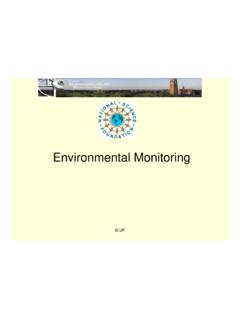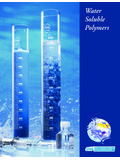Transcription of Chapter 7.3 Particulate matter - World Health Organization
1 WHO Regional Office for Europe, Copenhagen, Denmark, 2000 1 Chapter Particulate matter Introduction In the 1987 edition of Air quality guidelines for E urope (1), sulfur dioxide and Particulate matter (PM) were treated jointly. Short-term (24-hour average) guideline values were derived for combined exposure to sulfur dioxide and Particulate matter , expressed in black smoke , total suspended particulates and thoracic particles . Long-term (one-year average) guideline values were derived only for sulfur dioxide and black smoke.
2 At the time, published studies were inadequate to develop a guideline for thoracic particles per se. Therefore, the guideline value for thoracic particles was based on site-specific ratios for total suspended particulates to thoracic particles , and on a single study that also involved exposure to sulfur dioxide. In recent years, several studies have been published that permit direct evaluation of the Health effects of thoracic particles , because PM10 ( Particulate matter in which 50% of particles have an aerodynamic diameter of less than 10 m), which is essentially equivalent to thoracic particles , was actually measured in such studies.
3 Also, studies have been published that permit evaluation of the Health effects of PM10 alone, either because exposure to other pollutants was low or because adequate adjustment was possible. This Chapter focuses on evaluation of the Health effects of suspended particles in air, emphasizing studies that permit direct evaluation of associations with PM10, sulfate ion (SO4=), , and hydrogen ion (H+). The need to revise existing air quality guidelines and standards is widely felt, as many of the recent studies have suggested that significant effects on Health occur at levels below those that were seen as thresholds in the recent past (2).
4 General description Airborne Particulate matter represents a complex mixture of organic and inorganic substances. Mass and composition tend to divide into two principal groups: coarse particles mostly larger than m in aerodynamic diameter, and fine particles mostly smaller than m in aerodynamic diameter ( ). The smaller particles contain the secondarily formed aerosols (gas-to-particle conversion), combustion particles and recondensed organic and metal vapours. The larger particles usually contain earth crust materials and fugitive dust from roads and industries.
5 The fine fraction contains most of the acidity (hydrogen ion) and mutagenic activity of Particulate matter , although in fog some coarse acid droplets are also present (3). An idealized distribution of ambient Particulate matter is shown in Fig. 1. Particulate air pollution is a mixture of solid, liquid or solid and liquid particles suspended in the air (5). These suspended particles vary in size , composition and origin. It is convenient to classify particles by their aerodynamic properties because: (1) they govern the transport and removal of particles from the air; (2) they also govern their deposition within the respiratory system; and (3) they are associated with the chemical composition and sources of particles .
6 These properties are conveniently summarized by the aerodynamic diameter, that is the size of a unit-density sphere with the same aerodynamic characteristics. particles are sampled and described on the basis of their aerodynamic diameter, usually called simply the particle size . The size of suspended particles in the atmosphere varies over four orders of magnitude, from a few nanometres to tens of micrometres (Fig. 1). The largest particles , called the coarse Chapter Particulate matter Air Quality Guidelines - Second Edition WHO Regional Office for Europe, Copenhagen, Denmark, 2000 2 Fig 1.
7 Schematic representation of the size distribution of Particulate matter in ambient air (USEPA 1996) fraction (or mode), are mechanically produced by the break-up of larger solid particles . These particles can include wind-blown dust from agricultural processes, uncovered soil, unpaved roads or mining operations. Traffic produces road dust and air turbulence that can re-entrain road dust. Near coasts, evaporation of sea spray can produce large particles . Pollen grains, mould spores, and plant and insect parts are all in this larger size range.
8 The amount of energy required to break these particles into smaller sizes increases as the size decreases, which effectively establishes a lower limit for the production of these coarse particles of approximately 1 m. Smaller particles , called the fine fraction or mode, are largely formed from gases. The smallest particles , less than m, are formed by nucleation, that is, condensation of low-vapour-pressure substances formed by high-temperature vaporization or by chemical reactions in the atmosphere to form new particles (nuclei).
9 particles in this nucleation range or mode grow by coagulation, that is, the combination of two or more particles to form a larger particle, or by condensation, that is, condensation of gas or vapour molecules on the surface of existing particles . Coagulation is most efficient for large numbers of particles , and condensation is most efficient for large surface areas. Therefore the efficiency of both coagulation and condensation decreases as particle size increases, which effectively produces an upper limit such that particles do not grow by these processes beyond approximately 1 m.
10 Thus particles tend to "accumulate" between and 1 m, the so-called accumulation range. Submicrometre-sized particles can be produced by the condensation of metals or organic compounds that are vaporized in high-temperature combustion processes. They can also be produced by condensation of gases that have been converted in atmospheric reactions to low-vapour-pressure substances. For example, sulfur dioxide is oxidized in the atmosphere to form sulfuric acid (H2SO4). Nitrogen dioxide (NO2) is oxidized to nitric acid (HNO3), which in turn Chapter Particulate matter Air Quality Guidelines - Second Edition WHO Regional Office for Europe, Copenhagen, Denmark, 2000 3 reacts with ammonia (NH3) to form ammonium nitrate (NH4NO3).











